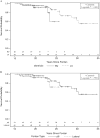Risk factors for major adverse events late after Fontan palliation
- PMID: 25130602
- PMCID: PMC4512755
- DOI: 10.1111/chd.12212
Risk factors for major adverse events late after Fontan palliation
Abstract
Objective: Risk factors for major adverse events late after Fontan palliation are unknown. Prior studies have suggested ventricular function and morphology as important risk factors. The aim of this study is to (1) characterize the late major adverse event profile in adult Fontan patients and (2) identify additional risk factors that may contribute to adverse outcomes.
Design and setting: A retrospective review of all adult patients >15 years post-Fontan seen at a tertiary academic center was conducted. Clinical, laboratory, cardiac data, and abdominal imaging were collected via chart review. Major adverse events (death, cardiac transplantation, or listing) were identified, and timing of events was plotted using Kaplan-Meier methods. Univariate and multivariate logistic regression was used to determine independent predictors of late-term events.
Results: A total of 123 adult Fontan patients were identified (mean time post-Fontan 22.4 years [±4.4]). Major adverse events occurred in 19/123 patients (15%). In this 15-year survivor cohort, transplant-free survival rates were 94.6%, 82.9%, and 59.8% at 20, 25, and 30 years postoperation, respectively. Modes of death were Fontan failure with preserved function (4), congestive heart failure with decreased function (2), sudden death (2), thromboembolic event (1), post-Fontan conversion (2), and posttransplant (2). No differences in adverse outcomes were found based on morphology of the systemic ventricle, Fontan type, or systolic ventricular function. On the other hand, features of portal hypertension (OR 19.0, CI 4.7-77.3, P < .0001), presence of a pacemaker (OR 13.4, CI 2.6-69.8, P = .002), and systemic oxygen desaturation (OR 0.86, CI 0.75-0.98, P = .02) were risk factors for major adverse events in the multivariate analysis.
Conclusions: In adult Fontan patients surviving >15 years post-Fontan, portal hypertension, oxygen desaturation, and need for pacemaker were predictive of adverse events. Traditional measures may not predict late-term outcomes in adult survivors; further study of the liver's role in late outcomes is warranted.
Keywords: Congenital Heart Defects; Fontan Procedure; Liver; Mortality; Survival.
© 2014 Wiley Periodicals, Inc.
Conflict of interest statement
Figures



References
-
- Khairy P, Poirier N, Mercier LA. Univentricular heart. Circulation. 2007;115(6):800–812. - PubMed
-
- Cetta F, Feldt RH, O’Leary PW, et al. Improved early morbidity and mortality after Fontan operation: the Mayo Clinic experience, 1987 to 1992. J Am Coll Cardiol. 1996;28(2):480–486. - PubMed
-
- Gersony WM. Fontan operation after 3 decades: what we have learned. Circulation. 2008;117(1):13–15. - PubMed
-
- Khairy P, Fernandes SM, Mayer JE, et al. Long-term survival, modes of death, and predictors of mortality in patients with Fontan surgery. Circulation. 2008;117(1):85–92. - PubMed
Publication types
MeSH terms
Grants and funding
LinkOut - more resources
Full Text Sources
Other Literature Sources

